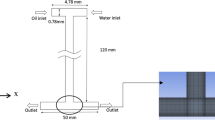Abstract
The use of microfluidics can improve the process of droplet formation while reducing energy consumption. In the present work, a microreactor system with a double T junction and oval microchannel reactor 2509 mm long was analyzed. The stream was composed of styrene, water, and an emulsifier. The concentration of water in the emulsion and the flow rates of water and styrene were evaluated. Droplets were observed at styrene/water flow rate ratios (Qd/Qc) ranging from 1:10 to 1:80. The simulations in the double T junction were carried out with laminar flow and the Volume Of Fluids model was selected for the phase interactions. Experiments with four flow rates of styrene and water were carried out. A simple optical system was used for in-line observation of droplets formed in the microreactor. For the flow ratio 1:1, there was no drop formation. For the other rates, droplets were observed from 59 to 200 μm. The droplets moved along the reactor maintaining shape and size. This fact indicated that the micro reaction system is suitable for developing a system that requires stability, such as emulsion polymerizations. The comparison between model and experimental results pointed out that these were reasonably represented by the model.










Similar content being viewed by others
References
Anna SL, Bontoux N, Stone HA (2003) Formation of dispersions using “flow focusing” in microchannels. Appl Phys Lett 82(3):364–366
Asua JM (2004) Emulsion polymerization: from fundamental mechanisms to process developments. J Polym Sci Part a Polym Chem 42(5):1025–1041
Costa ALR, Gomes A, Cunha RL (2017) Studies of droplets formation regime and actual flow rate of liquid-liquid flows in flow-focusing microfluidic devices. Exp Therm Fluid Sci 85:167–175
Fuerstman MJ, Garstecki P, Whitesides G (2007) Coding/decoding and reversibility of droplet trains in microfluidic networks. Science 315:828–832
Fullin L, Melloni E, Vianna AS Jr (2015) Solution styrene polymerization in a millireactor. Chem Eng Process 98:1–12
Garstecki P, Fuerstman MJ, Stone HA, Whitesides GM (2006) Formation of droplets and bubbles in a microfluidic T-junction—scaling and mechanism of break-up. Lab Chip 6:437–446
Ge XH, Huang JP, Xu JH, Chen J, Luo GS (2016) Water-oil Janus emulsions: microfluidic synthesis and morphology design. Soft Matter 12:3425–3430
Gupta A, Murshed SS, Kumar R (2009) Droplet formation and stability of flows in a microfluidic T-junction. Appl Phys Lett 94:164–177
Kokal SL (2005) Crude oil emulsions: a state-of-the-art review. Soc Pet Eng 20:5–13. https://doi.org/10.2118/77497-PA
Li XB, Li FB, Yang JC, Kinoshita H, Oishi M, Oshima M (2012) Study on the mechanism of droplet formation in T-Junction microchannel. Chem Eng 69:340–351
Maan AA, Nazir A, Khan MKI, Boom R, Schroën K (2015) Microfluidic emulsification in food processing. J Food Eng 147:1–7
Okushima S, Nisisako T, Torii T, Higuchi T (2004) Controlled production of monodisperse double emulsions by two-step droplet breakup in microfluidic devices. Langmuir 20(23):9905–9908
Peres JCG, Herrera CC, Baldochi SL, De Rossi W, Vianna AS Jr (2019) Analysis of a microreactor for synthesizing nanocrystals by computational fluid dynamics. Can J Chem Eng 97:594–603
Prakash M, Gershenfeld N (2007) Microfluidic bubble logic. Science 315:832–835
Purwanti N, Ichikawa S, Neves MA, Uemura K, Nakajima M, Kobayashi I (2016) B—lactoglobulin as food grade surfactant for clove oil-in-water and limonene-in-water emulsion droplets produced by microchannel emulsification. Food Hydrocolloids 60:98–108
Qiu D, Tonkovich AL, Silva LJ, Long RQ, Yang BL, Trenkamp KM, Freeman JA (2009) Process for forming an emulsion using microchannel process technology. U.S. Patent No. 7,485,671
Schindler M, Ajdari A (2008) Droplet traffic in microfluidic networks: a simple model for understanding and designing. Phys Rev Lett 100:044501:1-044501:4
Siqueira FC, Farias IS, Moraes Júnior D, Vianna AS Jr (2019) CFD simulation of annular oil flow wrapped with water. Can J Chem Eng 97(2):444–451. https://doi.org/10.1002/cjce.23326
Steegamans MLJ, Warmerdam A, Schroen KGPH, Boom RM (2009) Boom, Dynamic interfacial tension measurements with microfluidic Y-junctions. Langmuir 25:9751–9758
Sugiura S, Nakajima M, Yamamoto K, Iwamoto S, Oda T, Satake M, Seki M (2004) Preparation characteristics of water-in-oil-in-water multiple emulsions using microchannel emulsification. J Colloid Interf Sci 270:221–228
Thorsen T, Roberts RW, Arnold FH, Quake SR (2001) Dynamic pattern formation in a vesicle-generating microfluidic device. Phys Rev Lett 86:4163
Tice JD, Song H, Lyon AD, Ismagilov RF (2003) Formation of droplets and mixing in multiphase microfluidics at low values of the reynolds and the capillary numbers. Langmuir 19:9127–9133
Ushikubo FY, Oliveira DRB, Michelon M, Cunha RL (2015) Designing food structure using microfluidics. Food Eng Rev 7:393–416
van Rijn CJ, van Heugten WG (2017) Droplet formation by confined liquid threads inside microchannels. Langmuir 33(38):10035–10040
Vladisavljević GT, Kobayashi I, Nakajima M (2012) Production of uniform droplets using membrane, microchannel and microfluidic emulsification devices. Microfluid Nanofluid 13:151–178
Wehking JD, Gabany M, Chew L, Kumar R (2014) Effects of viscosity, interfacial tension, and flow geometry on droplet formation in a microfluidic T-junction. Microfluid Nanofluid 16(3):441–453
Wu Z, Sundén B (2019) Liquid-liquid two-phase flow patterns in ultra-shallow straight and serpentine microchannels. Heat Mass Transf 55(4):1095–1108
Yadav AK, Cal JC, Barandiaran MJ (2011) Feasibility of tubular microreactors for emulsion polymerization. Macromol React Eng 5:69–77
Yadav AK, Cal JC, Barandiaran MJ (2012) Synthesis of water-bone Polymer nanoparticles in a continuous microreactor. Chem Eng J 198:191–200
Yamanishi Y, Feng L, Fumihito A (2010) On-demand production of emulsion droplets over a wide range of sizes. Adv Robot 24(14):2005–2018
Zheng B, Tice JD, Ismagilov RF (2004) Formation of droplets of alternating composition in microfluidic channels and applications to indexing of concentrations in droplet-based assays. Anal Chem 76:4977–4982
Acknowledgements
This study was financed in part by the Coordenação de Aperfeiçoamento de Pessoal de Nível Superior—Brasil (CAPES)—Finance Code 001.
Author information
Authors and Affiliations
Corresponding author
Additional information
Publisher's Note
Springer Nature remains neutral with regard to jurisdictional claims in published maps and institutional affiliations.
Rights and permissions
About this article
Cite this article
Siqueira, F.C.S., Giannini, H. & Vianna, A.d.S. Droplet formation in oval microchannels with a double T junction: a CFD and experimental study. Braz. J. Chem. Eng. 38, 485–493 (2021). https://doi.org/10.1007/s43153-021-00133-2
Received:
Revised:
Accepted:
Published:
Issue Date:
DOI: https://doi.org/10.1007/s43153-021-00133-2




